How-to Article ...by Brad Mahs
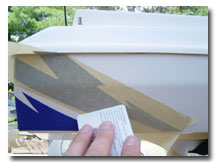
Learn how to make and install your own decals...
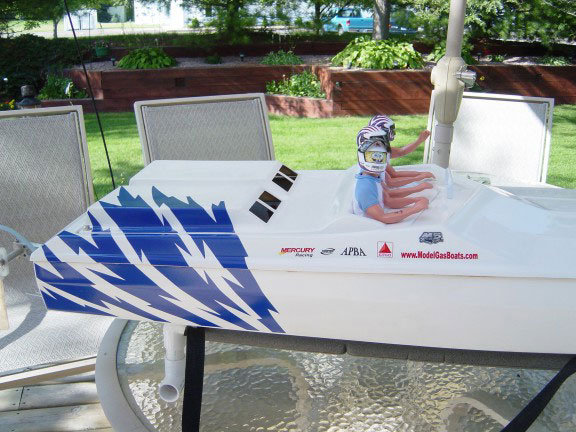
When it's time to personalize your boat, there are a few choices: have a pro paint it, paint it yourself, or simply put stickers or decals on it. Some people can't afford to pay for a professional paint job, or don't have the equipment, space, talent or patience to paint it themselves. I fall into the latter category: I have some paint equipment and decent artistic skills; but I have limited space and NO time to paint my own hulls! So when I wanted a trick graphic scheme, I decided decals would be the way to go – fast and easy!
I priced a few decal manufacturers, and they were all extremely helpful, and their pricing was very good. Any one of them would have done a decent job for me.
But, like everything else, I like to do things my way, by myself rather than buy!
There are a couple ways to create graphics; use adhesive backed vinyl ("stickers" I'll call them) or water-slide "decals". I'll explain both.
Vinyl Graphics
 There are lots of Internet sites (try Ebay)
that sell graphic vinyl sheets – I won't go into the intricacies of calendared
vs. extruded vs. cast vinyl types, etc. Do a little research and you'll learn a
lot!
There are lots of Internet sites (try Ebay)
that sell graphic vinyl sheets – I won't go into the intricacies of calendared
vs. extruded vs. cast vinyl types, etc. Do a little research and you'll learn a
lot!
I actually got lucky and went to the local surplus store; they had about 2 dozen different colored rolls of graphic vinyl, sold by the foot! I picked up a couple feet each of a variety of colors. For trimming, you could buy a computer controlled cutting machine, but you'd probably have to make a lot of decals to justify the cost! I simply used an X-acto knife, sharp scissors and a swivel knife.
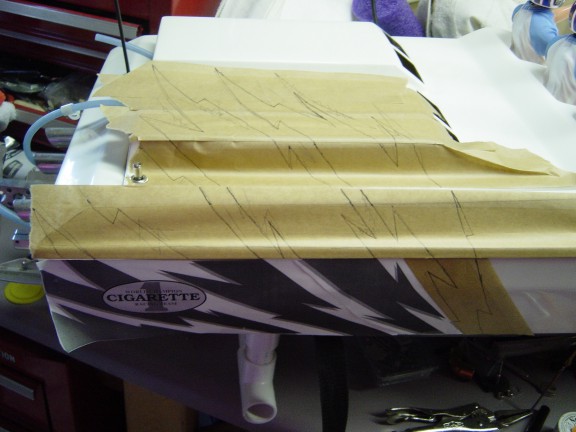 First step is the design stage. I used Microsoft Word, as well as
CorelDraw and Paint to create and play with various graphic designs. A simpler
method is to use paper, pencil and crayons or markers to design graphic themes.
Easier yet is to use logos and graphics you find, photocopy them and make
templates.
First step is the design stage. I used Microsoft Word, as well as
CorelDraw and Paint to create and play with various graphic designs. A simpler
method is to use paper, pencil and crayons or markers to design graphic themes.
Easier yet is to use logos and graphics you find, photocopy them and make
templates.
For my TeamStrike mono, I settled on a "torn lightening" graphic pattern along with some lettering and logos. The main tear graphic I decided to do with vinyl decal material, and the logos with inkjet water -slide decal paper. I created the majority of the pattern on the computer at a 1:1 scale, which allowed me to mirror and print patterns for both sides of the hull.
With a
concept ready, it was time to lay the pattern out. I covered the hull with a
combination of p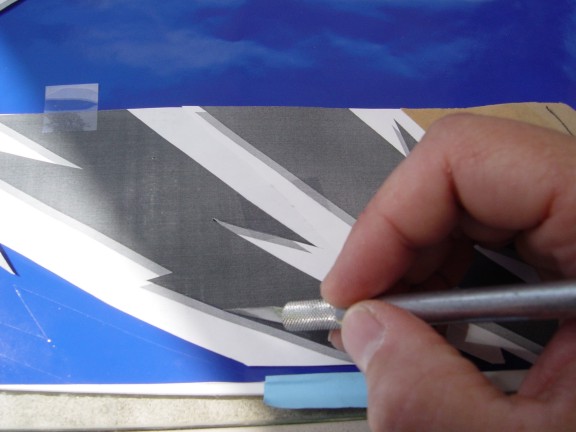 aper
and masking tape where the graphic will go, then sketched my patterns (along
with the computer printout for the main body of the graphic). After cleaning up
some lines, the paper/tape template was removed and further clean-up done. For
some pieces, I carefully cut out the various graphics with a sharp X-acto and a
scissors. For other pieces, I cut them out directly on the vinyl. Save the scrap
pieces for later!
aper
and masking tape where the graphic will go, then sketched my patterns (along
with the computer printout for the main body of the graphic). After cleaning up
some lines, the paper/tape template was removed and further clean-up done. For
some pieces, I carefully cut out the various graphics with a sharp X-acto and a
scissors. For other pieces, I cut them out directly on the vinyl. Save the scrap
pieces for later!
Next, I
spread out a piece of vinyl and arranged the graphics to maximize material
usage; keeping in mind I needed a right and left side. I trace cut into the
vinyl as 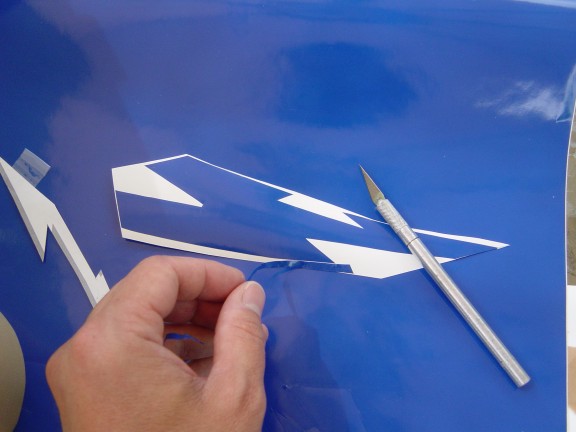 I followed around the graphics. For the
opposite side graphics, I simply flipped the hand drawn templates over and
re-used them.
I followed around the graphics. For the
opposite side graphics, I simply flipped the hand drawn templates over and
re-used them.
Cutting the vinyl requires a steady hand, and an EXTREMELY sharp knife! Try to set yourself up to make long, smooth cuts – rather than short choppy slices that will yield tears in the finished graphic. Make sure to over cut outside intersections so there are no "tabs" left. It is possible to cut through the vinyl without going all the way through the release paper backing, but if you do, it's no big deal.
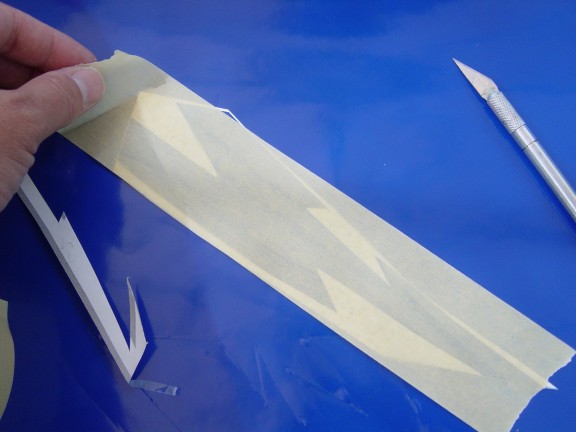 If you only cut through the vinyl, then it's time to "weed" out the
scrap. Use the tip of the knife to lift a corner and remove the scrap vinyl from
around the "good" graphic sections. Pull from inside corners outward; otherwise
the corners and tips will lift and could tear.
If you only cut through the vinyl, then it's time to "weed" out the
scrap. Use the tip of the knife to lift a corner and remove the scrap vinyl from
around the "good" graphic sections. Pull from inside corners outward; otherwise
the corners and tips will lift and could tear.
Prior to installing the vinyl, I first cleaned the area of the hull with alcohol and a tack rag.
There are a couple methods for putting the vinyl on that I'll describe. Some people recommend using liquids to aid in installing vinyl decals or stickers , since it allows the graphic to float over the surface for positioning prior to squeegee-ing. However, most professionals discourage this method if they want the graphic to last the longest amount of time possible. Neither of these methods uses liquids to install.
Note that with either method, you'll want to make sure you thoroughly wash and dry your hands, since dirty smeary fingerprints are probably not part of your design element!
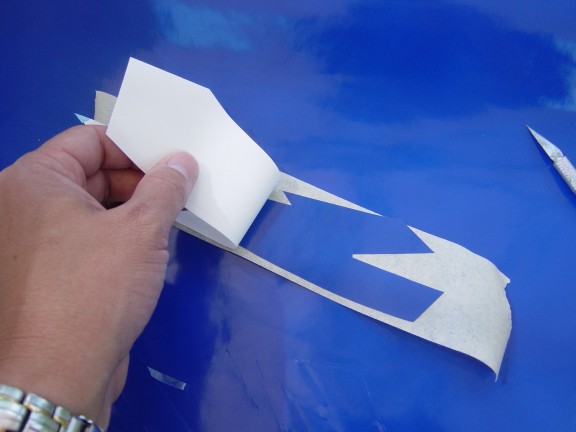 The first method is to use a transfer film.
This is a low tack carrier that is applied over the weeded vinyl image. Then the
release paper backing is removed from the vinyl and the sticker is positioned on
the mounting surface and held by the transfer film, while the vinyl is pressed
in place with finger pressure and a firm plastic squeegee removing air bubbles
as it's applied. Then, the transfer film is carefully removed. This method works
extremely well with various graphic images requiring specific placement (such as
lettering), and for installing large sheets of vinyl on intricate compound
surfaces.
The first method is to use a transfer film.
This is a low tack carrier that is applied over the weeded vinyl image. Then the
release paper backing is removed from the vinyl and the sticker is positioned on
the mounting surface and held by the transfer film, while the vinyl is pressed
in place with finger pressure and a firm plastic squeegee removing air bubbles
as it's applied. Then, the transfer film is carefully removed. This method works
extremely well with various graphic images requiring specific placement (such as
lettering), and for installing large sheets of vinyl on intricate compound
surfaces.
You can buy transfer film, or make your own by taking a wide roll of good quality 3M masking tape and "detacking" it; basically just press it onto a piece of clean linen and remove it. You want to remove the stickiness, but still have enough tack to hold the vinyl (but not so tacky that the vinyl won't come off without tearing!). You'll have to experiment a little with some vinyl scraps to find the right tackiness. And don't use the pet's favorite blanket to detack the tape – for obvious reasons!
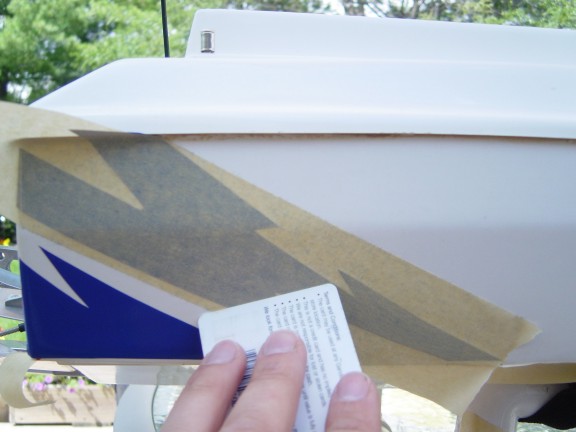 The other method is to cut around the
graphic, carefully remove the backing, then reapply the backing leaving a small
portion of vinyl adhesive exposed. Then the graphic can be positioned, the edge
pressed down, then the backing is peeled back as the vinyl is pressed down and
bubbles are removed as you go. This works well for small graphic
elements.
The other method is to cut around the
graphic, carefully remove the backing, then reapply the backing leaving a small
portion of vinyl adhesive exposed. Then the graphic can be positioned, the edge
pressed down, then the backing is peeled back as the vinyl is pressed down and
bubbles are removed as you go. This works well for small graphic
elements.
I used both methods for this graphic pattern. I started at the transom with the first piece using the transfer film method. Once I had the first graphic installed, I positioned the scrap from the cutout process next to it to determine where to place the next graphic element. After the next graphic element was installed, the process was repeated for the remainder until all the graphics were applied. I saved the scrap template pieces for the other side!
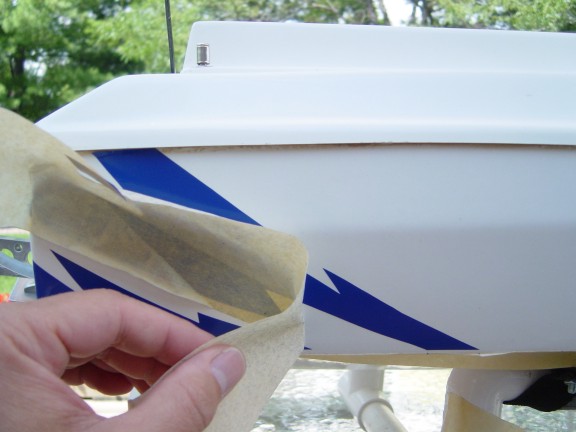 For small pieces, the graphic is aligned and the exposed adhesive
is tacked down along one edge. While holding the graphic away from the hull, the
exposed area of adhesive was pressed down, working back and forth making sure to
remove all air bubbles. Then the backing is removed, reattaching it onto the
very tip of the graphic (for something to hold onto, without having to touch the
adhesive on the vinyl). Using a stiff squeegee (credit card), the graphic is
pressed down evenly. Care is taken not to stretch or distort the graphic -
removing all air bubbles along the way. If you're careful, there won't be any
bubbles in the finished graphic. If there are, lightly cut them with a sharp
hobby knife and work the air out. It's best to work towards the ends of sharp
points to ensure the tips don't get snagged.
For small pieces, the graphic is aligned and the exposed adhesive
is tacked down along one edge. While holding the graphic away from the hull, the
exposed area of adhesive was pressed down, working back and forth making sure to
remove all air bubbles. Then the backing is removed, reattaching it onto the
very tip of the graphic (for something to hold onto, without having to touch the
adhesive on the vinyl). Using a stiff squeegee (credit card), the graphic is
pressed down evenly. Care is taken not to stretch or distort the graphic -
removing all air bubbles along the way. If you're careful, there won't be any
bubbles in the finished graphic. If there are, lightly cut them with a sharp
hobby knife and work the air out. It's best to work towards the ends of sharp
points to ensure the tips don't get snagged.
Repeat the installation process for the remaining graphic pieces until all are in place. Lastly, you should "burnish" the graphic down with firm strokes from the center to the edges to make sure it is evenly adhered. When burnishing, I use the release backing to protect the vinyl from scratches. Especially follow all the edges.
I have no experience clear-coating over vinyl graphics. One reason I use decals or stickers is so they can be removed if needed or wanted. Consulting a professional painter or doing some research will tell you what is necessary to clear-coat them.
One tip I would recommend: Avoid ending graphic elements with long, pointed tips or spikes. These areas are easily snagged when wiping down the hull and will typically be the first areas to peel away. This firmly falls into the "do as I say, not as I do" category!!
Decal Images
A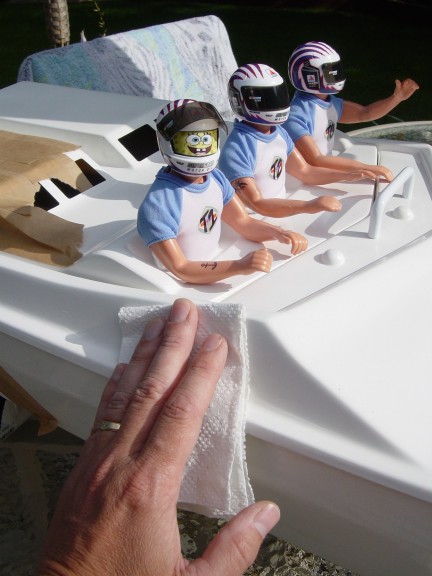 n easy, affordable method for creating small multi-colored logos,
pictures or lettering is to use water-slide decal paper and your PC color
printer. There are many companies who sell this stuff, both for inkjet and
laserjet printers, in both white and clear backgrounds. If you need a white
element in your decal, use the white background paper, since printers don't
typically print white ink. I used Bel Inc. Inkjet paper. This paper must be
sprayed with an acrylic clear coat to "set" the ink toner after it's
printed.
n easy, affordable method for creating small multi-colored logos,
pictures or lettering is to use water-slide decal paper and your PC color
printer. There are many companies who sell this stuff, both for inkjet and
laserjet printers, in both white and clear backgrounds. If you need a white
element in your decal, use the white background paper, since printers don't
typically print white ink. I used Bel Inc. Inkjet paper. This paper must be
sprayed with an acrylic clear coat to "set" the ink toner after it's
printed.
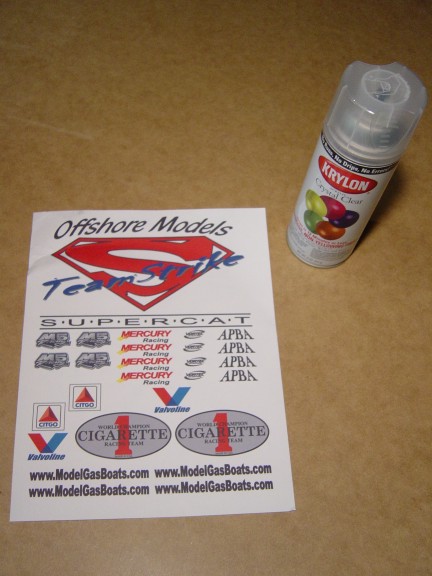 I chose some logos and lettering for my boat
and used a variety of software (CorelDraw, Paint, etc.) to create some graphics.
Ultimately, I brought everything into Word so I could arrange and print images
easily, maximizing the sheet of decal material. The graphic shown had a large
logo for my TS SuperCat; but unfortunately I was in such a hurry, I placed the
sheet in the printer upside down! When I reprinted it right side up my printer
started eating the paper, so I lost that graphic on the finished decal – and
then the toner ran out! I ended up using some of the all red logos anyway. But
it's a good lesson: make sure you know how to use your printer, and check your
toners!
I chose some logos and lettering for my boat
and used a variety of software (CorelDraw, Paint, etc.) to create some graphics.
Ultimately, I brought everything into Word so I could arrange and print images
easily, maximizing the sheet of decal material. The graphic shown had a large
logo for my TS SuperCat; but unfortunately I was in such a hurry, I placed the
sheet in the printer upside down! When I reprinted it right side up my printer
started eating the paper, so I lost that graphic on the finished decal – and
then the toner ran out! I ended up using some of the all red logos anyway. But
it's a good lesson: make sure you know how to use your printer, and check your
toners!  Make
sure your printer is in good shape, with fresh toner so the colors turn out
crisp.
Make
sure your printer is in good shape, with fresh toner so the colors turn out
crisp.
Follow the directions for the paper you use – for the Bel clear background paper, I printed using a Best Resolution setting.
I sprayed the entire printed sheet with several light coats of Krylon Clear Acrylic spray. This sets the inkjet toner on the sheet and protects it.
T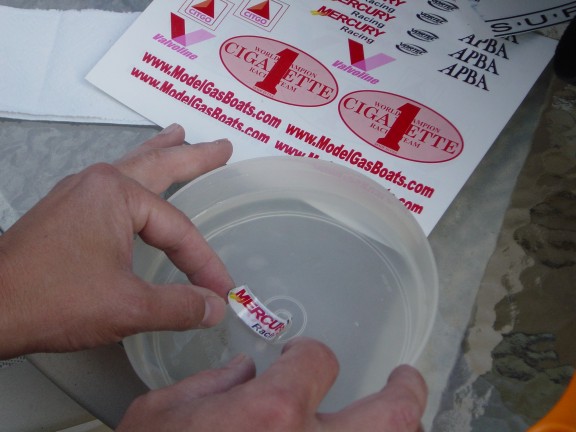 o apply the decal, I cut out one of the
images and test fit it, after cleaning/degreasing the hull. Next, I placed the
decal in a bowl of water for a minute until the decal moved on the protective
backing.
o apply the decal, I cut out one of the
images and test fit it, after cleaning/degreasing the hull. Next, I placed the
decal in a bowl of water for a minute until the decal moved on the protective
backing.
The decal was lifted out, the backing slid off and the decal was immediately placed on the hull and positioned. Using a clean lint-free cloth, I carefully squeezed the excess water and air bubbles out from underneath the decal, working from the center out. Once the decal was adhered, I dabbed away the excess water and waited for it to dry.
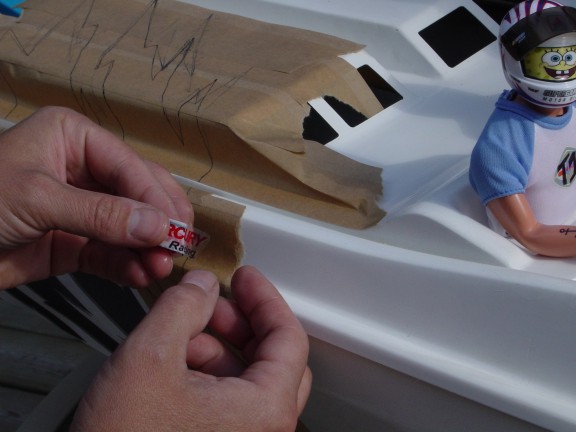 Some of the cons of the decal paper are that
it's tough to apply large images, it is not waterproof, and the decal ink is not
UV light stable.
Some of the cons of the decal paper are that
it's tough to apply large images, it is not waterproof, and the decal ink is not
UV light stable.
 Most decal papers recommend that a clear coat be applied over the
graphic if it is to be used outdoors, to waterproof them. I didn't want to clear
coat my entire boat, so I made a simple spray mask from tape to mask off the
surrounding hull. I cut the tape about 1/16" bigger than each decal image to
allow the clear spray to cover the decal, overlap onto the hull by 1/16" and
seal the surface and edges of the decal itself. Now water can't get at the decal
or ink.
Most decal papers recommend that a clear coat be applied over the
graphic if it is to be used outdoors, to waterproof them. I didn't want to clear
coat my entire boat, so I made a simple spray mask from tape to mask off the
surrounding hull. I cut the tape about 1/16" bigger than each decal image to
allow the clear spray to cover the decal, overlap onto the hull by 1/16" and
seal the surface and edges of the decal itself. Now water can't get at the decal
or ink.
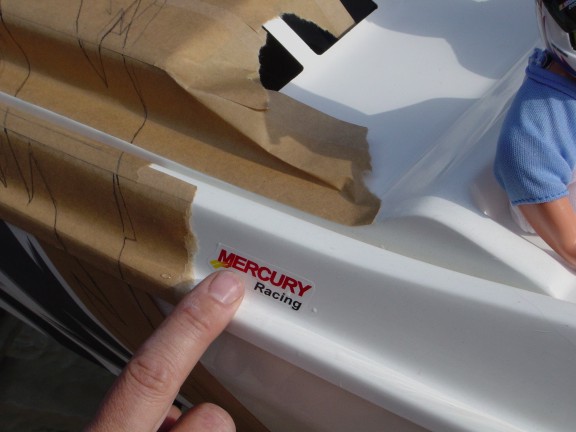 The
ink from an inkjet printer is not UV light stable, so the decal will fade with
prolonged exposure to the sun. Whenever possible, try to keep the hull covered,
or at least in the shade, when it's not being ran. This is common sense that
will help keep other parts of your boat long lasting as well (such as silicone
and rubber components).
The
ink from an inkjet printer is not UV light stable, so the decal will fade with
prolonged exposure to the sun. Whenever possible, try to keep the hull covered,
or at least in the shade, when it's not being ran. This is common sense that
will help keep other parts of your boat long lasting as well (such as silicone
and rubber components).
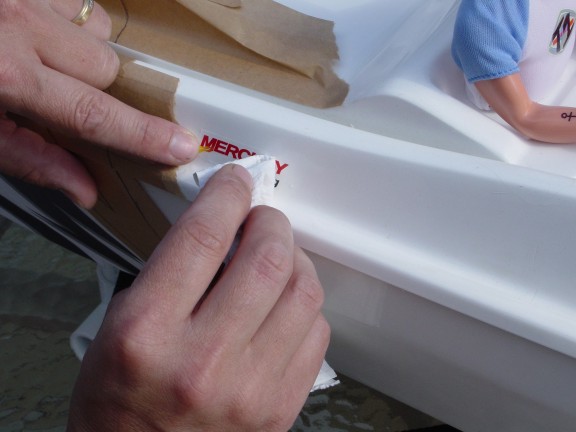 In my opinion, this decal stuff is great! It
makes attractive, full color decals and logos that would otherwise be impossible
to create with normal vinyl graphics, or even paint. Especially for people that
are not artistically gifted! Find alogo or image you like; scan it, print it,
spray it, apply it and you're done!
In my opinion, this decal stuff is great! It
makes attractive, full color decals and logos that would otherwise be impossible
to create with normal vinyl graphics, or even paint. Especially for people that
are not artistically gifted! Find alogo or image you like; scan it, print it,
spray it, apply it and you're done!
While inkjet decals probably don't have the longevity that paint or even vinyl does, I'm hoping it will last at least a couple seasons. Long enough to change my mind and create a new graphic scheme for next time!


